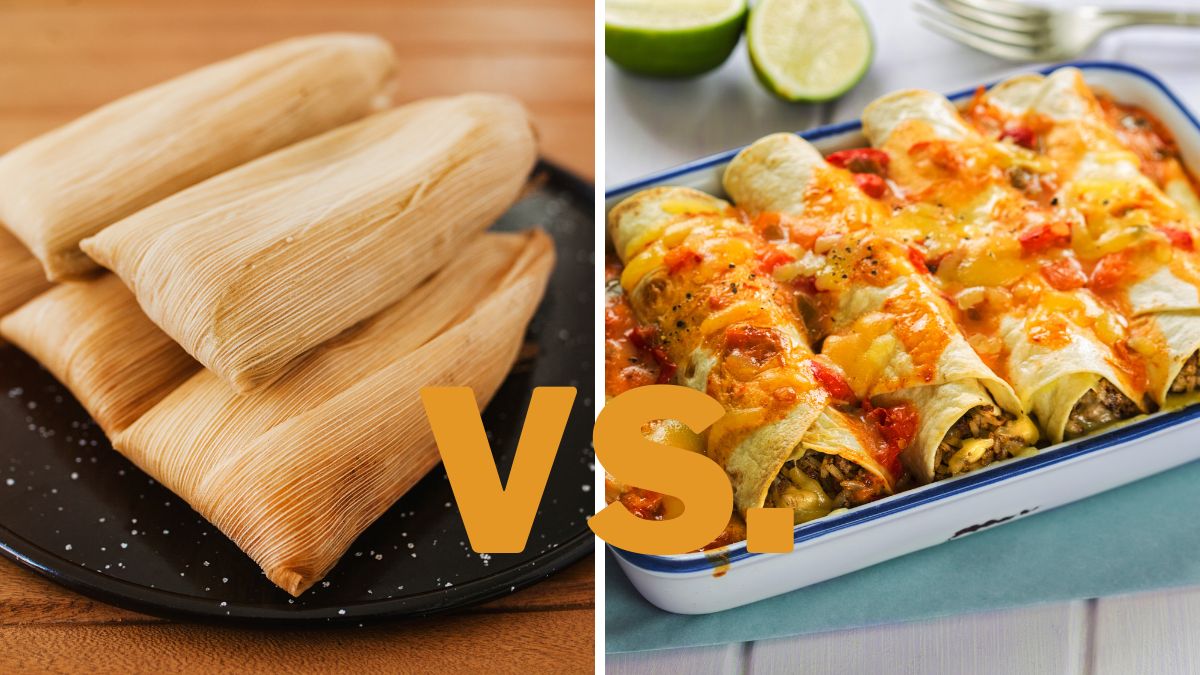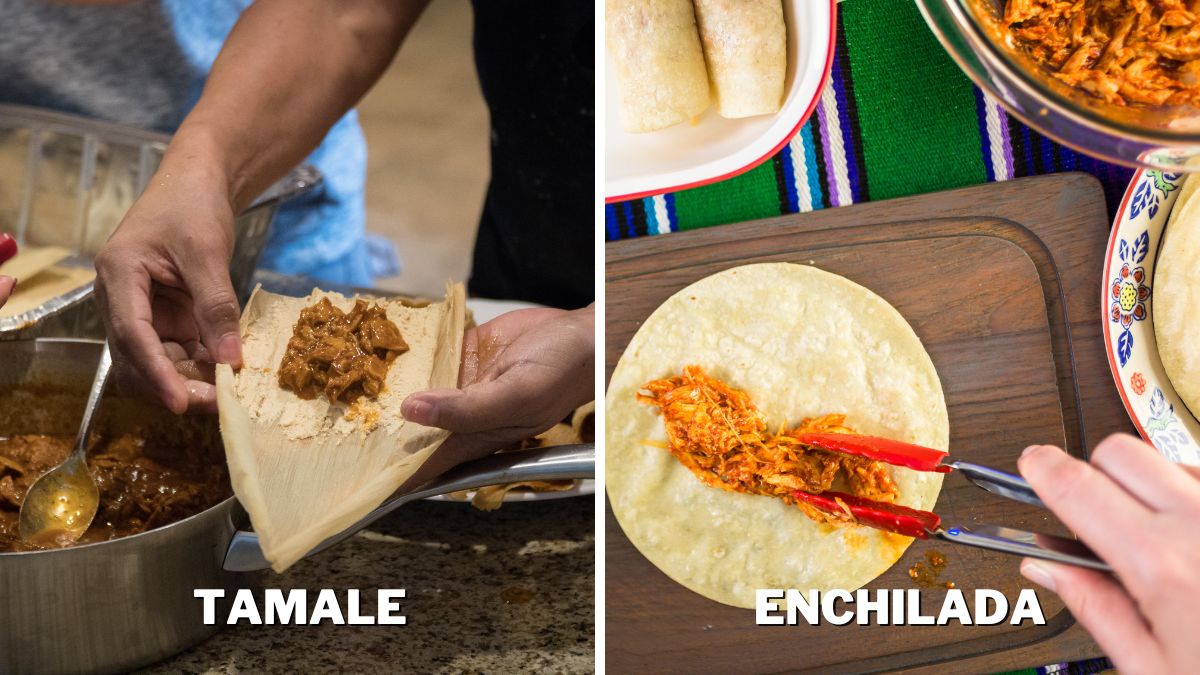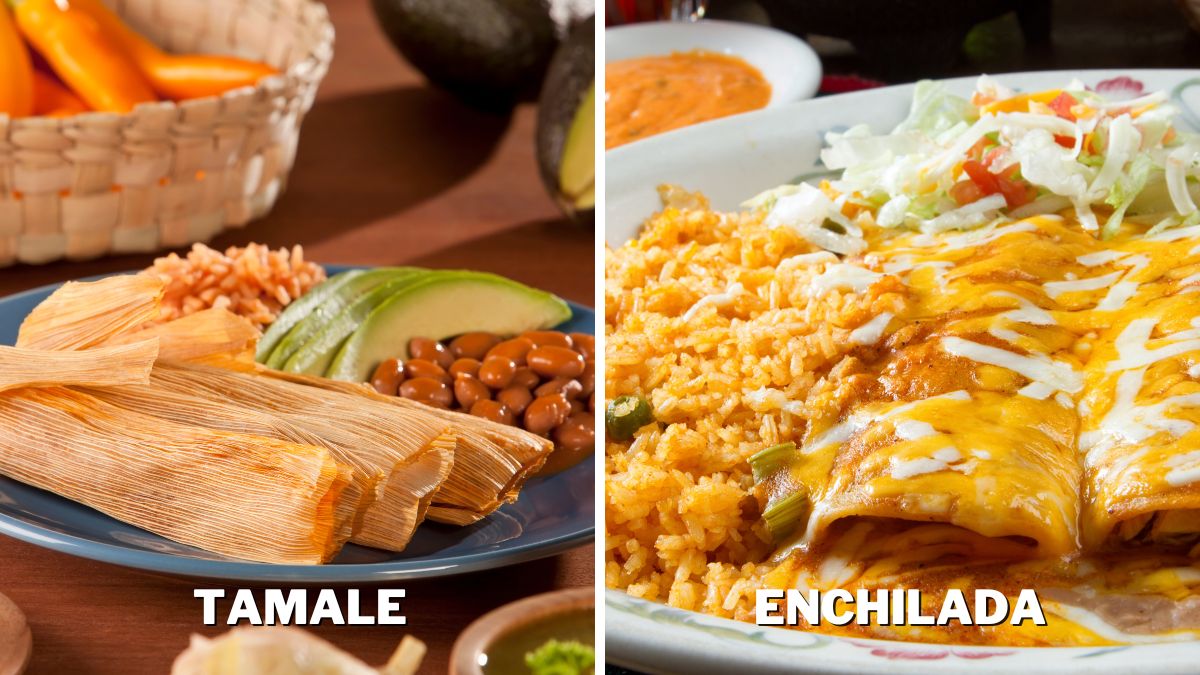Tamale vs. Enchilada: Differences & Serving Suggestions

When it comes to traditional Mexican cuisine, tamales and enchiladas are two of my all-time favorite dishes. There’s just something comforting about their flavors, aromas, and textures that instantly transports me to memories of family gatherings. While tamales and enchiladas may seem quite similar at first glance, being corn-based and often including meat and cheese, they actually have some key differences in their origins, ingredients, and taste.
While tamales date back to ancient Mesoamerica, enchiladas were created in Mexico in the 19th century. Tamales are steamed while enchiladas are baked, and the latter is spicier when it comes to taste.
If you’re trying to decide between these two delicious options for your next meal, let me give you a quick primer on what sets them apart so you can choose to satisfy your craving properly. So, why not start with the stories of their respectable origins?
Distinct Origins
Tamales date back to ancient Mesoamerica and were initially made from corn dough stuffed with meats and vegetables, then wrapped in corn husks or banana leaves and steamed. The Aztecs, Mayans, and Incas all had their own variations of tamales.
When the Spanish conquistadors arrived, they introduced new fillings like rice, raisins, and spices, resulting in the diverse tamales we know today.
Enchiladas, on the other hand, were created in Mexico in the 19th century. Corn tortillas are dipped in chili sauce, filled with ingredients like cheese, meat, or beans, and then rolled up and baked in more sauce and cheese. Enchiladas get their name from enchilar, a Spanish verb meaning “to season with chili.” While tamales are steamed, enchiladas are baked, giving them a different taste and texture.
In the first Mexican cookbook, El cocino mexicano (“The Mexican Chef”), published in 1831, and Mariano Galván Rivera’s Diccionario de Cocina, published in 1845, enchiladas are also listed as part of the remembrance of Mexican cuisine.
Key Ingredients that Set Tamales and Enchiladas Apart
Tamales are made of masa, a corn-based dough filled with meats and vegetables, wrapped in corn husks or banana leaves, and steamed. Enchiladas, on the other hand, are corn tortillas dipped in chili sauce, filled with ingredients like cheese, meat, or beans, and baked.
Masa, the dough used for tamales, is made from hulled corn that is soaked and ground. It has an earthy, corn-forward flavor.
Enchiladas get their distinctive taste from chili-based sauces made of ingredients like ancho or guajillo chiles, garlic, cumin, and oregano. The sauces permeate the tortillas and fillings, blending spicy, smoky, and savory flavors.
While tamales can be filled with nearly anything, a classic filling is pork in chili and tomato sauce. Shredded chicken, cheese, and vegetable fillings are also popular. Enchiladas are often filled with ingredients like cheese, shredded chicken, beef, or spinach and covered in chili sauce and cheese before baking.
Ultimately, tamales and enchiladas are both delicious and worthwhile, but they come down to preference. I find tamales comforting, while enchiladas satisfy my craving for bold, spicy flavors. Luckily, I don’t have to choose — I can enjoy them both!
Preparing Traditional Tamales vs. Enchiladas

Preparing tamales and enchiladas are two very different processes, even though they’re both popular Mexican dishes.
To make tamales, I start by soaking corn husks to soften them and then assembling the masa or corn dough. I add lard or vegetable shortening to the masa until it reaches a spreadable consistency.
Then I spread the masa onto the corn husks, add my filling of choice in the center – usually shredded pork, beef, or chicken and chili peppers – and wrap up the husks around the filling, tying them closed with string or strips of corn husks.
Once assembled, I place the tamales in a steamer over boiling water and steam until the masa is firm and separates easily from the husk, usually an hour. The steaming process gives tamales their distinctive taste and texture. Tamales can be served immediately but are often better the next day.
Enchiladas, on the other hand, start with corn tortillas that are dipped in enchilada sauce made of chili peppers and spices. The tortillas are then filled, rolled up, and placed in a baking dish, covered in more enchilada sauce and cheese before baking. Typical fillings for enchiladas include shredded chicken, ground beef, cheese, or vegetables.
Enchiladas are baked in the oven at 350 °F (180 °C) until the cheese is melted and bubbling, usually 20 to 30 minutes. The baking process gives enchiladas their distinctive melted, gooey texture.
Unique Flavor Profiles: Tamales Pack a Corn Punch While Enchiladas Bring the Heat
Tamales get their distinctive taste from masa, a corn dough made from hominy soaked and cooked in lime. The masa is stuffed with meats and vegetables, wrapped in corn husks or banana leaves, and steamed until the dough is firm. The result is a hearty, comforting dish with a subtle corn flavor.
Enchiladas, on the other hand, derive their flavor from chili-based sauces. Corn tortillas are dipped in enchilada sauce made from chilies like ancho, guajillo, or chipotle before filling and rolling. Popular fillings include cheese, onions, and spices.
The enchiladas are then covered in more sauce and cheese and baked until hot and bubbly. The chili sauce gives enchiladas a kick of heat and a tangy, savory flavor.
While I enjoy both tamales and enchiladas, I have to say enchiladas are my favorite. I just can’t resist their spicy, saucy deliciousness. Tamales satisfy when I’m craving comfort food, but enchiladas spice up my life.
Serving Suggestions: Tamale Toppings and Enchilada Accompaniments

When it comes to tamales and enchiladas, the toppings and sides are almost as important as the main dish itself. As a Mexican food lover, I have some suggestions to enhance your enjoyment of these delicious traditions.
For tamales, I highly recommend serving:
- Salsa – Whether red, green, or mole, salsa adds spice, acidity, and flavor. My personal favorite is a charred green chili salsa.
- Crema – This Mexican-style sour cream helps balance any spiciness and adds a creamy tang.
- Pickled vegetables – Quick-pickled carrots, onions, jalapeños, or radishes provide a bright, crunchy contrast to the soft tamale.
Besides, no tamale is complete without a dollop of fresh guacamole or at least some sliced avocado. Mashy avocado goodness – what’s not to love?
For enchiladas, suggested accompaniments include:
- Rice – Serve enchiladas with a side of Mexican rice, cilantro rice, or rice and beans. The starch helps soak up the enchilada sauce.
- Beans – Black beans or pinto beans make a hearty side for enchiladas.
- Salad – A simple tossed salad with chili-lime dressing adds freshness. Or try Mexican street corn salad for extra flavor.
Plus, crumbled queso fresco, a mild Mexican cheese, over the top of your enchiladas for a burst of saltiness in every bite.
With sides like these, your tamales and enchiladas will be a fiesta of flavors in every bite. Personally, I like to serve a few small sides with both tamales and enchiladas so people can mix and match to their heart’s content. That way, you get the best of all worlds on one delicious plate!
Which is your preferred way of serving each? I’m excited to hear your favorite serving combinations in the comments below!
